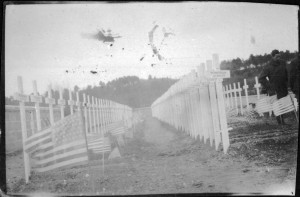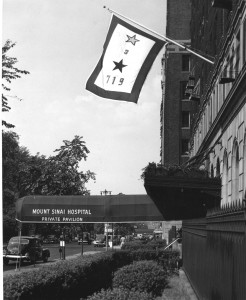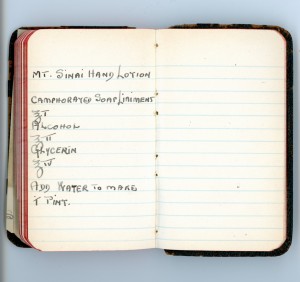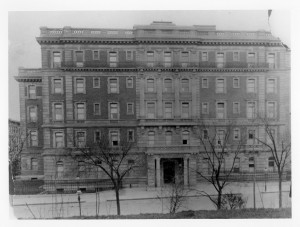May 24, 2016

The cemetery at Base Hospital No.3 for Americans who died at the hospital, 1918
Memorial Day is set aside to remember the servicemen and women who have died while in service to their country. Ceremonies started after the Civil War and it became a national holiday after World War II. Since injury and death are a part of war, doctors and nurses have always been witnesses to the ravages of battlefields. The image above shows the American cemetery at Base Hospital No. 3, the Mount Sinai Hospital-staffed unit that served in France.
While the deaths happened abroad, the biggest impact was felt at home. It was not only families that marked their losses, but institutions as well. By World War II, service flags were a familiar patriotic symbol. The photo below shows Mount Sinai’s flag hanging from 1184 Fifth Avenue. The number on the bottom shows how many Mount Sinai doctors, nurses, staff and trustees were in the service at that time. The gold star at the top showed how many had died. By the end of the war, Mount Sinai’s numbers had grown to 802 served, nine dead.

The Mount Sinai Hospital service flag, 1944
Those nine are recognized here:
- Nils Carson
- Sydney C. Feinberg, MD
- Andrew Goldstein
- Jerome W. Greenbaum, MD
- Eugene M. Holleb, MD
- Goodell G. Klevan, MD
- Bernard Ritter, MD
- Helen Rogers, RN
- Stanley J. Snitow, MD
May 13, 2016
As the Mount Sinai Archives continues processing and cataloging the records of the Beth Israel Medical Center (today’s Mount Sinai Beth Israel), we continue to discover interesting images and ephemera from Beth Israel’s history.

The photograph above shows Albert Einstein with Adolph Held (1885-1969), editor of the Jewish Daily Forward and brother of Dr. Isidor W. Held, a longtime member of the Beth Israel Hospital medical staff who served as President of the Medical Board from 1936 to 1938. (Update June 2017: When we first discovered this photograph in the collection, it had been incorrectly identified as a photograph of Dr. Held rather than his brother Adolph. Thanks to the family member who contacted the Archives with a correction.)
Dr. Held, a gastroenterologist, was involved in Jewish refugee aid in the aftermath of World War I, and during the rise of Nazism he became active in the movement to help medical and scientific emigres escape from Nazi Germany and its conquered territories, raising funds and publishing articles on behalf of persecuted Jewish physicians. These activities brought him into contact with Albert Einstein, who was himself a refugee from Nazi persecution and a vocal activist on behalf of other potential emigres.
This photograph is the only item in the Beth Israel collection that documents the relationship between Einstein and Dr. Held, but the Einstein Archives Online, a comprehensive directory of Einstein’s manuscripts, includes numerous entries for letters to and from Held and his wife Fanny. In 2006, a 1938 letter from Einstein to Held discussing the situation in Germany was sold at auction; the catalog listing includes a translation of the letter, which discusses their unsuccessful attempts to help an internist named Rudolph Ehrmann escape the “German gangsters.” (The following year, they were successful in obtaining passage to New York City for Dr. Ehrmann, who opened a private practice and became one of Einstein’s personal physicians.)
Dr. Held passed away in 1947. In addition to his legacy as an administrator, clinician and teacher of house staff, and the lives he saved as a refugee advocate, his posthumous impact at Beth Israel included an important annual lecture series endowed in his memory, which lasted until at least the late 1980s and brought numerous prominent physicians to BI’s downtown campus.
May 2, 2016
In honor of National Nurses Week, the Mount Sinai Archives would like to recognize that for over 100 years, Mount Sinai nurses have been doing it all, and then some. When she was a student at The Mount Sinai Training School for Nurses, Class of 1917, Sybil E. Elzas created a little notebook containing important things she needed to know on her clinical rotations, and then once out on her own as a graduate nurse. (Most professional nurses at this time still did private duty nursing, not hospital work.) The notebook was sized just right to slip into the pocket of her uniform’s apron. After pages and pages of definitions of terms and lists of operating room tray set-ups and dressings, towards the back of the book is a lone page noting the recipe for “Mount Sinai Hand Lotion.” Why purchase something nurses could so easily make, and at reduced cost?!
Nurses, still making a difference at Mount Sinai, 100 years later.

Inside cover of the clinic notebook belonging to Sybil E. Elzas. She is shown here as a student while on rotation to Sloane Hospital. The recipe for the lotion is at the end of the volume.

Apr 22, 2016
The Mount Sinai Archives has installed its latest quarterly exhibit in the lobby of the Annenberg Building. This season’s exhibit, “Hospital Trustees and the Making of New York City,” looks at the role of some of the trustees of the Mount Sinai Health System hospitals, accomplished figures who left their mark not only on their respective hospitals but on New York City as a whole.
One exhibit case contains photographs and memorabilia documenting the life and career of Charles H. Silver, who served for nearly five decades as President of the Board of Trustees at the Beth Israel Medical Center, the predecessor of today’s Mount Sinai Beth Israel. (Some of the highlights of the Mount Sinai Archives’ Silver collection have previously been featured on the blog.) The child of impoverished Lower East Side immigrants who worked his way up to wealth and influence, Silver was active in politics and philanthropy, chaired the New York City Board of Education, and was a pioneer of interfaith relations in a multicultural global city.

Pictured: The original Mount Sinai Private Pavilion, built in 1904 with an endowment from the Guggenheim family.
The second exhibit case documents the legacy of the Guggenheim family at Mount Sinai. The role of the Guggenheims in New York City philanthropy is perhaps best known in connection with the Guggenheim Museum, but members of the family also played an important role at Mount Sinai, where they served as Trustees, donors, and vocal supporters from 1889 until the end of the 20th century. Since 1904, their name has been on Mount Sinai’s largest patient care building, a symbol of their dedication to the city and people of New York.
This quarter’s Nursing History exhibit, located underneath the stairs to Stern Auditorium, documents the participation of Mount Sinai School of Nursing graduates in the Spanish-American War and the Spanish Civil War, the latter of which marks its 80th anniversary this year.
Apr 15, 2016

Dr. S. S. Goldwater, Director of The Mount Sinai Hospital from 1903-1928
Every month is a celebration of something, and April is National Poetry Month. In keeping with the season, the Mount Sinai Archives would like to offer up a poem. This was written by S. S. Goldwater, MD (1873-1942). He served as the Director (COO) of The Mount Sinai Hospital from 1903-1928 and also served as the New York City Commissioner of Health and the Commissioner of Hospitals. He was known as one of the foremost consultants on hospital architecture in his era, and helped create the field of modern hospital administration. He loved to write poetry and often exchanged poems with his friends. He wrote the poem below for the celebration of The Mount Sinai Hospital’s 90th anniversary in 1942, just a few months before he died. It was reprinted in a memorial booklet after his death:
In closing, let me address these lines to your distinguished President, to your faithful and energetic Director, and to those members of the Board and Staff with whom it was my privilege to be associated for a time in the development of this great institution:
Full many a year has passed since you and I
Began to think in unison, and talk
Of what a hospital is and what it should be.
Well, thoughts like ours do not die a-borning
But, seized by eager wills, emerge as deeds,
By which new shapes are formed, reshaped again,
Until the world about us is part Nature’s,
Part our own.
Although we’ve not achieved
The perfect institution of our dreams—
Of love, and art, and science all compact—
Rejoice we may, for we have lived to see
The hospital we cherish yield to change
From small to great, from careless to exact,
From home of sorry pestilence to proud
And comely scene of perfect cleanliness
Equipped with all that science knows to aid
Physician, nurse, and sick, to whom in honor
We pledge again our faithful, firm support.







